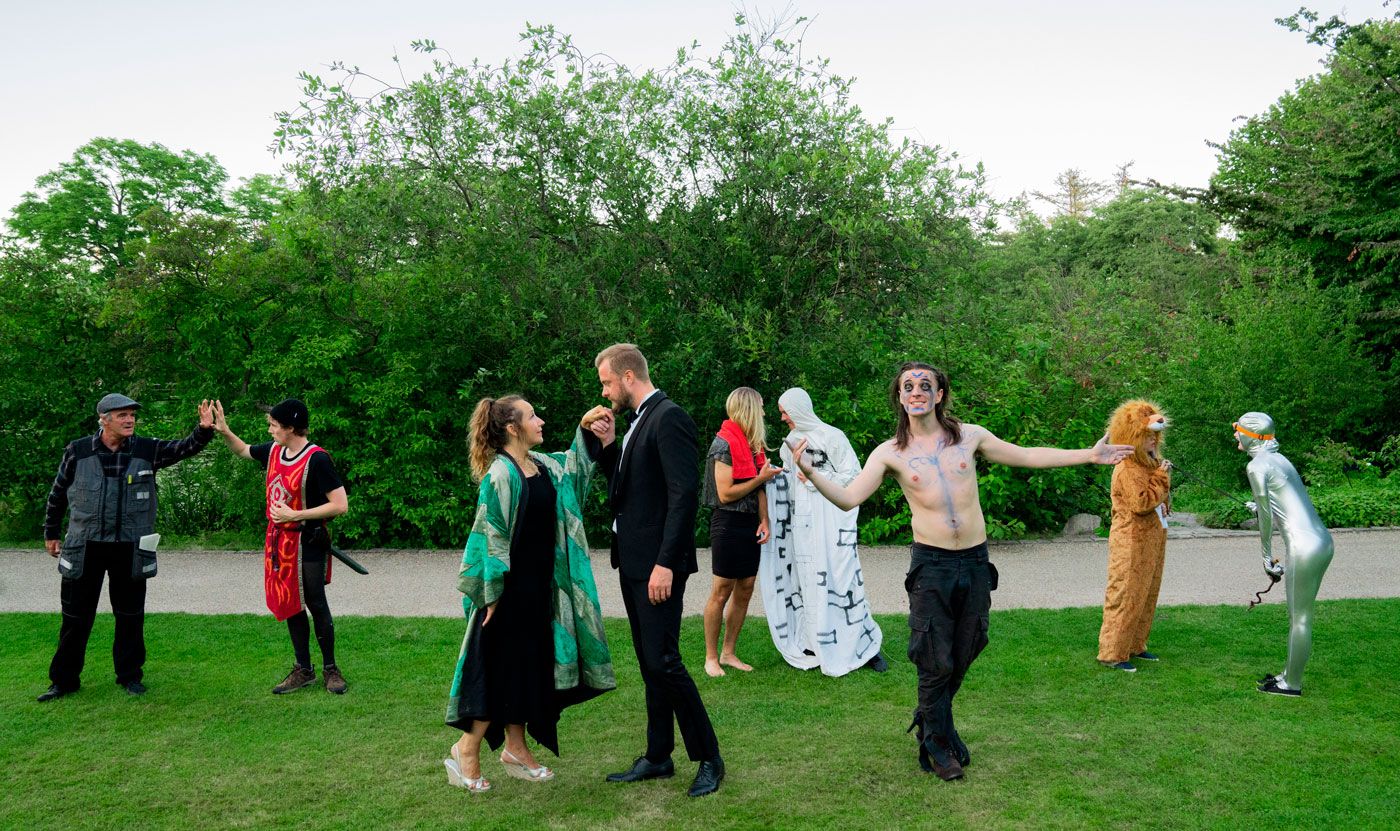On a midsummer’s night, on a grassy bank sloping down to the Botanical Gardens’ magical, flower-fringed lake, a strange dream is unfolding under the open sky.
The audience are sprawled on picnic blankets, drinking wine, faces lit with late sun and expectation. It’s the third year that Shakespeare’s ‘A Midsummer Night’s Dream’ will be performed en plein air. By now a longstanding success, 2021’s version of the ancient fairy soap-opera is no different.
Am I hallucinating?
Last year’s cast is reunited – with the addition of Kevin Kiernan-Molloy as Bottom – in an Athenian oasis-in-the-city. Set against the urban mumble of people and traffic, there’s a tangible ‘glitch in the matrix’ feel to the whole production.
Is that not the perfect stage for the hypnagogic hallucinations of Shakespeare’s most malleable play? And brevity being the soul of wit, this version clocks in at a lean 105 minutes.
It’s a fast and frivolous rendition of a dressed-down Athens in silk slips and floral shirts with nudge-nudge-wink-wink allusions to modern life.
As immersive as a bona fide daydream, director Thomas Magnussen and the After Hours Theatre Company have pulled it out of the bag again.
Stand-up for starters
The performance opens with an ebullient observational stand-up routine from Jefferson Bond. It’s well-placed: light fun and the assurance of a good time for Shakespeare first-timers.
Bond’s court-jester charm and energy carries through the entire production in his roles as the obstreperous Puck and Philostrate too. Sporting a devilish grin and carnivalesque tendrils of blue body paint on his face and chest, Bond’s feisty and physical performance is a dramatic anchor of the play.
Puck’s master, the fairy king Oberon, is played by Rasmus Emil Mortensen. True to the Midsummer Night’s Dream tradition of actors doubling up, Mortensen also plays Theseus. Belted, buckled and fur-draped as Oberon and strapped into a sharp suit as Theseus, Mortensen exudes macho dynamism and virility in both rather butch roles.
A solid love-square
Playing opposite, as Hippolyta and Titania, Linda Elvira is a honey-voiced and sensuous matriarch. Exaggerated male and female energy find harmony here – a nice structural contrast to the chaos of the four lovers. It’s not her first Shakespeare-rodeo and her work as a voiceover artist makes those old, much-repeated words glow with fresh vibrancy.
There’s more casting success with Søren Højen as Demetrius and Benjamin Stender as Lysander, who are wonderfully matched. Each is petulant, sarcastic, melodramatic, earnest and slapstick as a pie-eyed pawn in the famous love-square.
As Lysander, Stender carries much of the script’s comedic weight – a responsibility deftly borne with sharp comic timing and expressive voicing. Højen shines, too, as Flute the Mechanical – spineless and lip-trembling beneath Quince’s withering directorial glower.
Whereas Højen and Stender’s performances mirror one another, their respective flames, Helena and Hermia, played by Alexandra Jespersen and Thea Bell Schok, are Yin and Yang.
Jespersen is a wounded, tragi-comic Helena and clownish Starveling, dancing on the line between fire-breathing scorn and wilting self-deprecation in a standout performance.
Meanwhile, wide-eyed and headstrong, Schok’s Hermia is a perfectly executed girl-next-door: a rebel and victim of daddy-Egeius’ territorial parenting.
Experience speaks
Ian Burns’ stage-time as Egeius is short, of course, but his history in theatre is long and varied. He worked extensively in England before founding That Theatre Company in Denmark in 1997 and his experience is palpable in his stage presence. As Quince, Burns’ masterful expressions of exasperation, frustration, and the frantic orchestrating of the Mechanicals are a pleasure to watch.
In the only casting change from last year, Kevin Kiernan-Molloy – known for soaps, series, films, and stage performances across Australia and Europe – has stepped into the role of buffoonish Bottom. His voice projection and range are fantastic, as is his dynamic use of space on the ‘stage’ (or bank in this case).
Molloy’s Bottom is enthralling, oscillating between blokey and camp with thick overtones of narcissism and cutting humour. Though he’s acting, it seems as if he’s dancing. Molloy is a figure whose performance leaves ripples after the curtain (or dusk in this case) drops.
A strange stage and a stranger year
This year’s show also reunites the creative forces that helmed previous runs: Reumart-winning Magnussen’s artistic consultant Lars Mikkelsen is a long-time friend and colleague. Meanwhile, stage manager Angelique Giroir is back to choreograph the unconventional stage demands of stepping around pond-birds and using real undergrowth as a prop.
A few topical gags have made the bill since last year: facemasks make an appearance, as do vaccine plasters on all the actors’ shoulders. The narrative of separated lovers fits seamlessly with lockdown frustrations for many of us. A running joke of post-jab arm-soreness played out with grimaces of pain at every bump roused a response every time.
Though cliché by now, corona jokes have become some of the lowest hanging laughs out there. They’re practically inevitable. In this instance they were tastefully peppered for maximum effect,
Was it all a dream?
But lo! The clock’s iron tongue hath told, erm… eight forty-five… and the audience awakes to ordinariness again. A smartphone, a bus home, a tide of swift-heeled commuters sweeping past the garden gates. But everything has a shine to it – some element of otherworldliness seems to cling to drab reality.
That’s the intoxicating charm of ‘A Midsummer Night’s Dream’ and it has never dimmed in its centuries of performance. Right now, pure escapism and a little mischief is the kind of tonic we all need. As live events gather momentum again, few can promise to pull it off like this.














